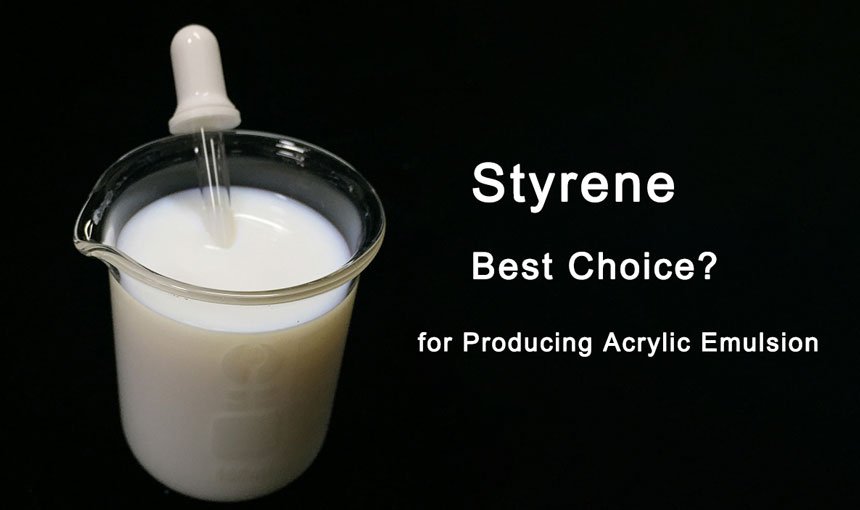Styrene is widely considered to be an important material for waterborne acrylic emulsions in 2025, with a high-performance combination of safety, water and chemical resistance, weather resistance, durability and growing affordability.
Editor: Jason (iSuoChem Marketing Operations Director &Professional Engineer. Has been in the industry since 2014.)
Information reference: Wikipedia, schem.net
What's Styrene?
Styrene (chemical formula: C8H8) is a monomer composed of a benzene ring and a vinyl group, with a molecular weight of 104.15 g/mol, a density of 0.9 g/cm³, and a boiling point of 145°C. Due to the high reactivity of the vinyl groups in its molecular structure, styrene readily polymerizes, and therefore stabilizers are often added to extend its shelf life.

Main Roles of Styrene in Waterborne Acrylic Emulsion Synthesis
1. Improving Coating Hardness and Rigidity
According to ICCA, styrene is a hard monomer, and its homopolymer has a high glass transition temperature (Tg). Incorporating styrene into water based acrylic emulsions significantly improves the coating's hardness, abrasion resistance, and deformation resistance. The rigid structure of the benzene ring restricts the movement of the polymer molecular chain, thereby enhancing the coating's scratch resistance and mechanical strength.
2. Improving Water and Chemical Resistance
Styrene's hydrophobic benzene ring structure reduces the number of hydrophilic groups in the polymer, reducing water absorption and improving water resistance. Furthermore, styrene copolymer emulsions are more stable against acids, alkalis, and electrolytes, making them suitable for applications requiring corrosion or chemical resistance.
3. Enhanced Weatherability and Durability
The benzene ring structure absorbs some UV rays, reducing light-induced degradation of the polymer, thereby delaying yellowing and chalking of the coating. This property makes styrene-acrylic copolymer emulsions (styrene acrylic emulsions) ideal for outdoor applications such as exterior architectural coatings and industrial protective coatings.
4. Reduced Production Costs
Compared to acrylic monomers (such as methyl methacrylate (MMA), styrene is less expensive. Therefore, incorporating an appropriate amount of styrene into waterborne acrylic emulsions can reduce raw material costs while maintaining performance.
5. Major Styrene Manufacturers
International Companies: Multinational chemical giants such as BASF, LG Chem, and LyondellBasell dominate the global styrene supply. LyondellBasell's styrene monomer plant in the Netherlands has an annual production capacity of 640,000 tons, making it one of the largest production facilities in the world.
Chinese Companies: Hengli Petrochemical, Rongsheng Petrochemical, CNOOC Shell Petrochemical Company, and Sinopec Zhenhai Refining and Chemical Company are major domestic styrene producers, accounting for a significant share of the national market.
The following table summarizes the main functions of styrene in waterborne acrylic emulsions:
|
Main role |
Mechanism of action |
Improved performance |
|
Improve the hardness and rigidity of the coating |
Benzene is a hard monomer (high Tg), and the structure of benzene ring restricts the movement of molecular chain |
Enhance wear resistance, scratch resistance and mechanical strength |
|
Improve water/chemical resistance |
The hydrophobic benzene ring reduces the density of hydrophilic groups and reduces the water absorption rate |
Improve water resistance, acid and alkali corrosion resistance, suitable for humid or chemical environment |
|
Enhance weather resistance |
Benzene rings absorb ultraviolet light and slow down photo-oxidation degradation |
Reduce yellowing and powdering and prolong outdoor coating life |
|
Reduce production costs |
The price of styrene is lower than that of acrylic monomers (such as MMA) |
Optimize raw material costs while maintaining performance
|
Major Chinese Suppliers of Styrene Acrylic Emulsion
iSuoChem is a key supplier of styrene acrylic resins (Styrene Acrylic Emulsion/waterborn acrylic emulsion) in China. The company specializes in the research and development and production of water-based resins. Its styrene-acrylic copolymer emulsions are widely used in architectural coatings, industrial coatings, and adhesives. With their stable performance and cost advantages, they have secured a significant share of the domestic market.
Conclusion
By 2025, Styrene Acrylic Emulsion will be the preferred choice for interior and exterior building coatings, outperforming other available options in terms of safety, longevity, weatherability, and affordability.
FAQ
Q1: Why does waterborne acrylic emulsion need styrene? Can't pure acrylic esters be used alone?
A: Pure acrylic ester emulsions offer excellent flexibility, but it lack hardness and durability.
Styrene can optimize performance by achieving a balance between hardness and cost, improving durability, and expanding applications. So styrene acrylic emulsion is especially suitable for applications requiring both hardness and toughness (such as architectural exterior paints and industrial anti-corrosion coatings).
Q2: Does styrene affect the environmental performance of waterborne acrylic emulsions?
A: This needs to be evaluated from two aspects:
VOC issue: Styrene itself is a volatile organic compound (VOC). But styrene is copolymerized in the water-based emulsion system, resulting in extremely low residual monomer levels (in compliance with GB/T 23986-2020 standards).
Toxicity controversy: Styrene is classified as a Class 2B carcinogen (IARC), but the polymer is non-toxic after film formation. Then the industry can reduce residual risk through process optimization (such as post-process devolatilization).
Q3: How can the quality of styrene acrylic emulsions be judged?
A: Key indicators include:
Glass transition temperature (Tg): This determines the hardness or softness of the coating and must be tailored to the application (for example, the Tg for exterior wall paint is typically 20-40°C).
Water resistance testing: For example, water absorption after 24 hours of immersion in water (<5% for high-quality emulsions).
Weather resistance data: QUV accelerated aging testing (e.g., no chalking after 1000 hours, ΔE <2).
Supplier qualifications: For example, whether companies like iSuoChem provide complete environmental certifications (GB, ISO, SGS, or REACH) and third-party testing reports.